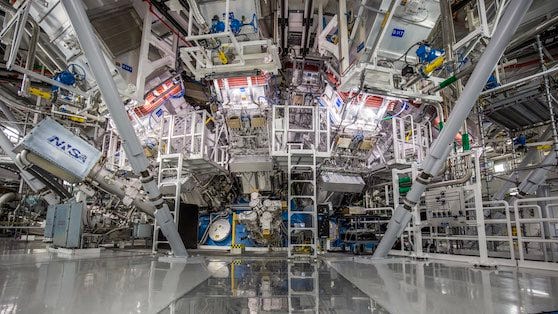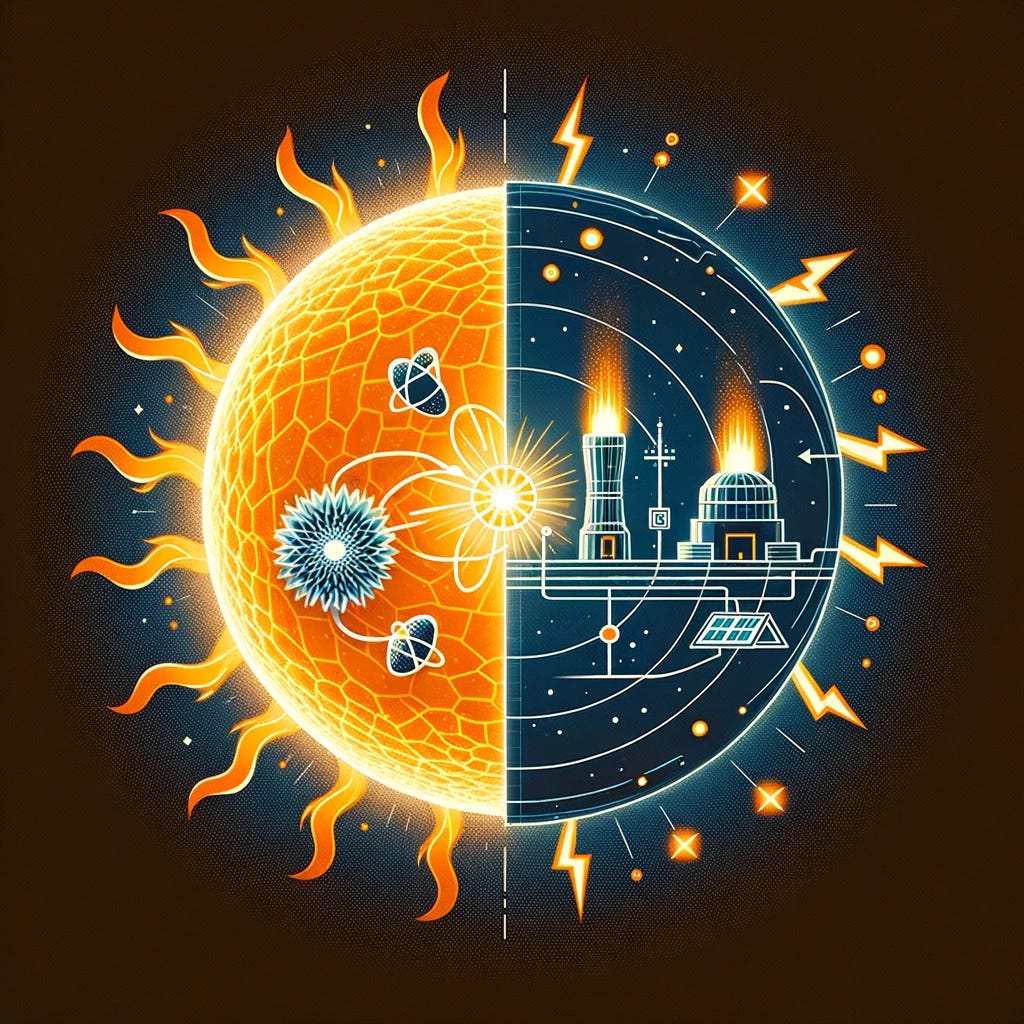Introduction: Reflecting on Energy’s Insatiable Quest
My mission for this newsletter is for “Ethics and Algorithms” to be like ZDNet or CNET but for the deep tech revolution. Beyond AI and machine learning which is a main focus here, this newsletter presents technological and ethical progress impacting the future of work and life. One of these is Hydrogen Fusion. It is the process that powers the sun. Scientists have been researching ways to harness fusion as a clean and virtually limitless energy source on Earth. Fusion reactions release vast amounts of energy, which can potentially be used for power generation.
According to the US Department of Nuclear Energy, all of the energy we produce comes from basic chemical and physical processes. That’s mostly been accomplished throughout history by burning carbon-based material like wood, coal and gas—or by harnessing power from the sun, wind, and water. Fission and fusion are two physical processes that produce massive amounts of energy from atoms. They yield millions of times more energy than other sources through nuclear reactions. You can check out the difference between the two in this video.
Fission
Uranium and plutonium are most commonly used for fission reactions in nuclear power reactors because they are easy to initiate and control. The energy released by fission in these reactors heats water into steam. The steam is used to spin a turbine to produce carbon-free electricity.

Fusion
Fusion reactions are being studied by scientists, but are difficult to sustain for long periods of time because of the tremendous amount of pressure and temperature needed to join the nuclei together. By merging hydrogen atoms under extreme pressure and temperature, we can unleash a torrent of energy, capable of powering civilizations without the environmental toll of fossil fuels.
Unpacking the Star in a Bottle: The Science of Fusion
what we do in these experiments is we try to recreate the process that fuels the sun and the stars and the solar system. So, the energy source in the sun is hydrogen atoms, deuterium and tritium, which are essentially heavy hydrogen atoms fusing together. When they fuse together, they create a helium atom and a neutron, which carries energy away from the reaction. And so, in the sun, the way that works is gravity: the sun’s very big, it has very large gravitational fields, so it squeezes the fuel in the center of the sun together and that fusion process is sustained over time. That’s why the sun burns and is bright.
In the laboratory, how do we create conditions where we can squeeze this little fuel pellet that we have for long enough and hold it together for long enough that those fusion reactions can begin to burn and self-sustain over time? That’s the trick, really, that we’ve been working on for all this time. We use a little different process than the sun, because we don’t have a gravitational field in our experiments that’s of that scale, so we use a process called inertial confinement. We take a little can, called a hohlraum – it’s about a centimeter long and maybe half a centimeter in diameter – and we shine a lot of laser energy into that. So we shine 192 laser beams into that little can, about two megajoules of laser energy.
And what we did in December is produce more fusion energy out than we had laser energy into the process. So two megajoules laser energy in, three megajoules fusion out, which was super, super exciting. It’s the first time that’s ever been done in the laboratory.
Imagine two atoms, the fundamental building blocks of matter, squeezed together under immense pressure and heat. At these extreme conditions, exceeding 100 million degrees Celsius and pressures millions of times greater than the atmosphere, something extraordinary happens. The nuclei of these atoms overcome their natural repulsion and fuse, releasing a tremendous amount of energy in the form of light and heat. This, in essence, is the process that powers our sun and countless other stars.

Lawrence Livermore Lab
Replicating this stellar feat on Earth, however, is no easy feat. It requires creating an environment that mimics the conditions within a star. Here’s where the two main approaches to fusion come into play:
1. Magnetic Confinement Fusion: This method utilizes powerful magnetic fields to confine and control a superheated plasma, a state of matter where electrons are stripped from atoms, creating a soup of charged particles. By manipulating these fields, scientists can shape and control the plasma, allowing fusion reactions to occur within a designated chamber, like a giant donut-shaped device called a tokamak.
2. Inertial Confinement Fusion: This approach takes a different tack, using high-powered lasers or particle beams to compress and heat a target pellet containing fusion fuel, typically isotopes of hydrogen. The immense pressure and heat trigger fusion reactions within the pellet, releasing a burst of energy in a controlled explosion.
Both approaches present unique challenges and opportunities, and the race is on to achieve the elusive goal of sustained, commercially viable fusion energy.
A Future Bathed in Starlight: The Promise of Fusion
The implications are staggering. We could usher in an era of energy independence, mitigating geopolitical tensions and fostering global cooperation. We could power our cities, industries, and transportation systems with minimal environmental impact, paving the way for a sustainable future.
A Beacon of Innovation: Pioneering Efforts Around the Globe
While Dr. Kim Budil and her team at Lawrence Berkeley National Lab (LBL) are at the forefront of fusion research, they are not alone in this global endeavour. A vibrant community of scientists and engineers across the globe are pushing the boundaries of what’s possible:
- The Joint European Torus (JET) project: Holding the record for the highest fusion power output in a magnetic confinement device, JET is a testament to international collaboration in this field.
- The ITER project: Under construction in France, ITER represents a massive leap forward, aiming to demonstrate the feasibility of fusion energy for peaceful purposes.
- The Massachusetts Institute of Technology (MIT) Plasma Science and Fusion Center: Renowned for its pioneering research in various fusion concepts, MIT continues to play a crucial role in advancing the field.
- The Commonwealth Fusion Systems (CFS) project: This private venture is developing a novel approach using high-temperature superconductors, showcasing the diverse efforts in the pursuit of fusion.
These are just a few examples of the many institutions and companies actively contributing to the advancement of fusion energy. Their collective efforts, expertise, and diverse approaches are crucial in accelerating progress towards this shared goal.

Fusion energy
The Glimmering Promise and Ethical Murk of Fusion Energy
The sheer scale and complexity of fusion projects raise concerns about resource allocation. Should we be pouring billions into this unproven technology when there are pressing needs in other areas? This is a valid question, and one that demands thoughtful consideration.
Furthermore, the development of fusion necessarily involves experimentation with powerful forces. The potential for accidents, even if statistically low, cannot be entirely disregarded. How do we ensure the responsible development and deployment of this technology, safeguarding both human lives and the environment?
The Rise of the Machines: AI and the Fusion Equation
Imagine AI algorithms analyzing vast datasets of plasma behaviour, identifying subtle patterns and anomalies that might escape the human eye. Or envision AI-powered control systems fine-tuning the magnetic fields or laser pulses in real-time, optimizing fusion reactions for maximum efficiency.
However, the integration of AI into such a critical technology also raises ethical concerns. Issues of bias, transparency, and control over AI systems need careful consideration. We must ensure that AI serves as a tool for good, augmenting human decision-making rather than replacing it altogether.
The ethical considerations surrounding AI extend beyond the technical realm. As AI plays an increasingly prominent role in shaping fusion research and development, we must ensure that these powerful algorithms are developed and deployed in a responsible and ethical manner. This necessitates robust governance frameworks, public discourse, and ongoing vigilance to mitigate potential risks and biases.
A Glimpse into the Future: A Futurist’s Perspective
1. The Optimist’s Dream:
In this scenario, scientific breakthroughs pave the way for commercially viable fusion reactors by the mid-21st century. Fusion energy becomes the dominant source of clean power, revolutionizing energy security and mitigating climate change. Global cooperation flourishes as nations collaborate to develop and deploy this transformative technology.
2. The Cautious Path:
This scenario acknowledges the significant challenges inherent in fusion development. Progress is slower than anticipated, with technical hurdles and resource constraints delaying commercialization. However, continued research and international collaboration eventually lead to a gradual transition towards fusion energy, albeit at a slower pace than the optimist’s dream.
3. The Unforeseen Disruption:
This scenario posits the emergence of unforeseen technological advancements that disrupt the current trajectory of fusion development. Perhaps a breakthrough in alternative clean energy sources like solar or geothermal surpasses fusion in terms of cost-effectiveness and scalability. Alternatively, significant advancements in energy storage technologies could render large-scale baseload power generation, like fusion, less necessary.
Conclusion: A Call to Ethical Action in the Fusion Journey
The future of fusion energy remains uncertain, yet the potential rewards are simply too significant to ignore. As we navigate this uncharted territory, it’s imperative to embrace a multifaceted approach. Continued investment in research and development is crucial, alongside robust ethical considerations and public engagement.
Ultimately, the success of fusion energy hinges not only on scientific breakthroughs but also on our collective commitment to responsible development, international collaboration, and a shared vision for a sustainable future. The stars may hold the key to unlocking this clean energy source, but it is up to us to ensure its responsible and ethical application on Earth.
This journey towards harnessing fusion energy is an odyssey fraught with both challenges and opportunities. It compels us to confront complex ethical questions, demanding a thoughtful and nuanced approach. But amidst the uncertainties, one thing remains clear: the potential rewards are simply too significant to ignore. As we navigate this uncharted territory, let us remember that the true power of fusion lies not just in its ability to illuminate our world, but also in its potential to illuminate the path towards a more sustainable, equitable, and ethically responsible future. The choice, ultimately, lies in our hands. Will we embrace the potential of this deep tech marvel, or will we allow fear and uncertainty to dim its glimmer.
Last Things
You can contact Kevin on WhatsAPP which is the best way to connect personally and professionally.
Join Kevin’s Inner Circle and the “Baker on Business” letter. The Inner Circle is Kevin’s email broadcast list for his Baker on Business letter. Each issue contains an article not published anywhere else dealing with executive level topics and discussions directly related to growth and current economic trends and data. This is the only source for exclusive specials on digital courses, news about upcoming engaging podcasts, advance special book pricing, riveting live sessions, Mastermind groups, and recorded videos. It’s all here. It’s all free. Your dedication fuels our passion to share. 🚀
Coming Soon:
Baker on Business newsletter is coming to Substack. Click here if you would rather read on Substack.
Business and Leadership Mastermind Group with Kevin Baker-Australia! This is a fee-based peer mentoring experience.

This term, Kevin is once again an adjunct academic teaching the masters level course “Analytics and Consulting” at the School of Information Systems and Technology Management | UNSW Business School | UNSW Sydney. This is for students in the Master of Analytics and Master of Commerce programs. In 2023 he was “on loan” from ITSM teaching “Managing With Digital Technology” to MBA students at The Australian Graduate School of Management at UNSW Business School.
By day, Kevin is COO at Hardware and General Supplies Ltd. in Sydney. They are a 63 year-old family-owned wholesale and retail supplier of building, plumbing, and industrial suppplies to residential and commercial builders, plumbers, and industry.
Go here to get past full issues or subscribe to this newsletter.
This experimental) newsletter is (purposely) stuffed with formatting, spelling and other strategic mistakes.
Most of the ideas, research, frameworks (and even big chunks of the writing) are as a direct result of (or completely lifted from) my partnership with Katie Baker, aka wife.
Hey, did you know…
–Kevin has a podcast…The Peak of Potential.
Listen on Apple Podcasts Listen on Spotify Listen on Google Podcasts
#EthicsInTech #DeepTech #HumanPotential #SelfActualization #AI #Futureognition #KnowledgeLegacy #TechPhilosophy #CognitiveEvolution
